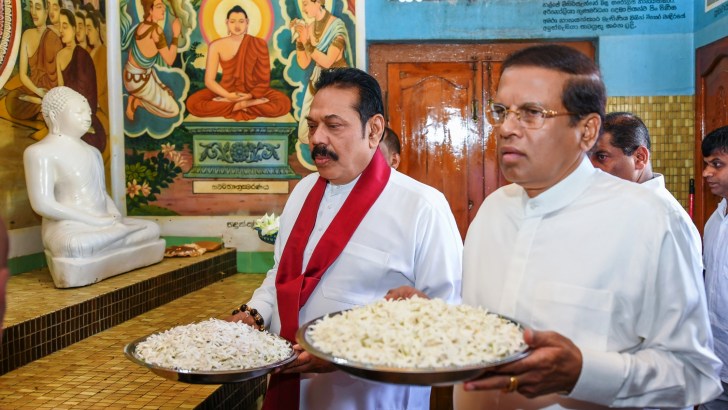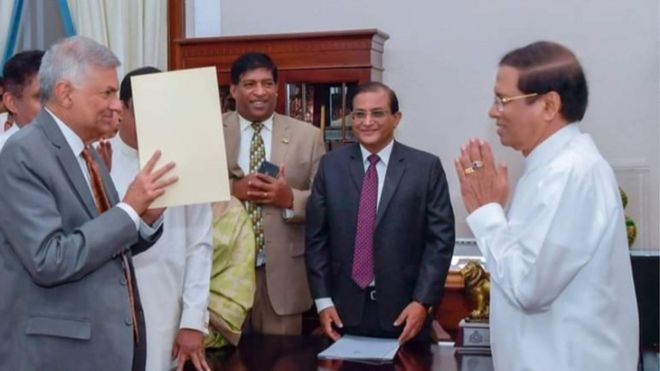Sri Lanka rode the roller coaster in 2018
Posted on December 29th, 2018
By P.K.Balachandran/Daily Express Courtesy NewsIn.Asia
Colombo, December 28: Sri Lanka saw cataclysmic political events in 2018. Democracy, which was introduced way back in 1931 and was thought to be well and truly entrenched in Sri Lanka, was put in danger in October-November when President Maithripala Sirisena dismissed Prime Minister Prime Minister Ranil Wickremesinghe and dissolved parliament in brazen violation of the country’s constitution.
Wickremesinghe was sacked on October 26, even though he was enjoying the support of the majority in parliament. And parliament was dissolved on November 9, in violation of the 19 th. Amendment of the constitution which had removed the discretionary power of the President in this matter in 2015.

However, after 50-odd days of continuous but peaceful struggle led by the media and civil society, a seven-judge bench of the Supreme Court restored democracy by unanimously nullifying the sacking of the Prime Minister and the dissolution of parliament.
Long History
But the events which led to the drastic action of the President have a history going back to February 2015.And the issues involved have deep roots. Therefore, the animosities underlying the conflict between President Sirisena and Prime Minister Wickremesinghe will remain to haunt Sri Lankan politics through 2019 and 2020 when provincial, Presidential and parliamentary election will hopefully bring the curtains down on them.
In the short term, there is little evidence to suggest that the Lankan government will function smoothly. Even after re-installing Wickremesinghe in his office, President Sirisena has continued to be unsparing in his criticism of the Prime Minister. He still holds on to the view that Wickremesinghe and his cohorts are corrupt, arrogant and anti-national” and that he was right in sacking them and saying that he would not appoint Wickremesinghe as PM even if all the 225 members of parliament demand it.”
The President-Premier tussle is only set to intensify because Sri Lanka is to have provincial, Presidential and parliamentary elections in 2019-2020.
To carry the political fight forward, Sirisena has formed an unofficial alliance with his former rival and present comrade-in-arms, Mahinda Rajapaksa, to take on the common enemy, Wickremesinghe.
Facing a Sirisena-Rajapaksa combine in the coming elections is not going to be easy for Wickremesinghe because his stock among the masses is low given his neo-liberal policies and lackluster performance as a development initiator and development implementer since he assumed charge as Prime Minister in January 2015.
Wickremesinghe’s mettle was tested in the local bodies’ elections of February 2018. The United National Party (UNP) led by him, came a poor second to Rajapaksa’s fledgling outfit, the Sri Lanka Podujana Peramuna (SLPP).
Deep Set Animosity
The sacking of Wickremesinghe and the installation of Rajapaksa as Prime Minister on October 26 was only a climax of a long drawn out conflict between President Sirisena and Prime Minister Wickremesinghe.
The President and his outfits the Sri Lanka Freedom Party (SLFP) and the United Peoples’ Freedom Alliance (UPFA) felt sidelined and deprived of power by the Prime Minister and his UNP. The latter enjoyed primacy as the senior partner in the coalition with more members in parliament.
A section of the SLFP/UPFA, which had always had serious reservations about being in alliance with traditional rival UNP led by Wickremesinghe, wanted Sirisena to break with the UNP/UNF and go into an alliance with former President Rajapaksa who was, after all, the chairman of the SLFP and UPFA for almost two decades.
The Central Bank Bonds Scam which came to light in February 2015 was the first irritant in the relationship. The scam involved Central Bank Governor Arjuna Mahendran ( a close friend of Wickremesinghe’s) and Mahendran’s stock broker son-in-law Arjuna Aloysius.
Gentle efforts by Sirisena to persuade Wickremesinghe to bring Mahendran to book were stonewalled. Subsequently, Sirisena set up a Presidential Commission to investigate the scam which he dubbed as robbery”. The commission found Mahendran culpable, but the Prime Minister took no steps to get him extradited from Singapore. Sirisena felt disregarded by the Prime Minister and his cohorts in this as well as other matters.
Overtime, Sirisena also found that the Prime Minister and the clique around him were taking decisions without taking him into confidence though he is the repository of executive power as a directly-elected Executive President, and not just a ceremonial President of Sri Lanka.
There were ideological differences too. While Wickremesinghe was neo-liberal, pro-West and internationalist, Sirisena was leftist and nationalist.
Sirisena disapproved of the deal with China on the Hambantota port and prevented the Colombo Port East Container completion project from going to India. Apparently, a number of other joint ventures with India were also thwarted by Sirisena. Later, Sirisena openly accused Wickremesinghe of selling off” national assets to foreign entities.
In an effort to steer economic decision-making his way, the President set up his own Economic Council in competition with a cabinet economic council set up by Wickremesinghe. The President also countermanded several economic decisions which he felt were anti-people.
Sirisena opposed Wickremesinghe’s policy of meeting the West’s and the UN’s demands on human rights and ethnic reconciliation at the cost of sovereignty, majority and military rights. He vehemently criticized the arrest of military personnel for deeds allegedly committed during the war against terrorists.

Initial Reluctance
In 2017, moves to break ties with the UNP were initiated by a ginger group in the SLFP and the UPFA. But Sirisena was against the idea because he still felt obliged to Wickremesinghe and the UNP for getting him elected as the President in January 2015. Sirisena was the candidate of the Joint Opposition led by UNP and its leader Wickremesinghe.
When moves to get somebody other than Wickremesinghe from the UNP to take up the Premiership failed, and pressure to sack Wickremesinghe mounted, Sirisena agreed. But he was told by his lawyers that under the 19 th.Amendment of 2015, the President had no power to sack the Prime Minister so long as the latter had majority support in parliament. And Wickremesinghe had such support.
However, after the February 10,2018 local bodies’ elections, in which Rajapaksa’s SLPP took control of an overwhelming majority of the 341 councils which went to the polls, 16 SLFP ministers left the Sirisena-Wickremesinghe government and sat with the Joint Opposition Group led by Rajapaksa.
Later, they moved a Motion of No Confidence against the Prime Minister. But this failed because Sirisena developed cold feet at the eleventh hour apparently because of pressure from India which is believed to have wanted Wickremesinghe to be Premier. The motion was defeated.
However, those SLFP members who had quit the coalition government kept mounting pressure on Sirisena to leave the alliance, or at least sack Wickremesinghe. It was then that Sirisena took the drastic step of reaching out to Rajapaksa and offering him the Premiership.
Rajapaksa, cooling his heels in the opposition, fell for the bait and grabbed the opportunity with alacrity. Rajapaksa assumed that given his established popularity, he would be able to get enough support from all sections of parliament to establish a stable government.
But this was not to be. Slighted by the way Sirisena removed Wickremesinghe, the UNP/UNF combine closed ranks, and despite dissatisfaction with Wickremesinghe’s performance as a leader, insisted that he, and only he, will be the PM.
The President prorogued parliament to give Rajapaksa time to get majority support in the 225-member parliament. When he failed, parliament was dissolved.
But the judiciary stayed the dissolution. When parliament met, two No Confidence Motions against Rajapaksa were passed. Subsequently, Parliament also passed a Motion of Confidence in Wickremesinghe.
Meanwhile, the President continued his campaign to fix Wickremesinghe by asking the Central Bank to start a forensic audit of the bonds scam. He also decided to oppose the Sri Lanka-Singapore Free Trade Agreement. A committee appointed by him had alleged that it was signed without adequate consultation with all Lankan stakeholders.
(The featured image at the top shows President Maithripala Sirisena and Prime Mahinda Rajapaksa at a Buddhist shrine after they got together to oust Wickremesinghe)